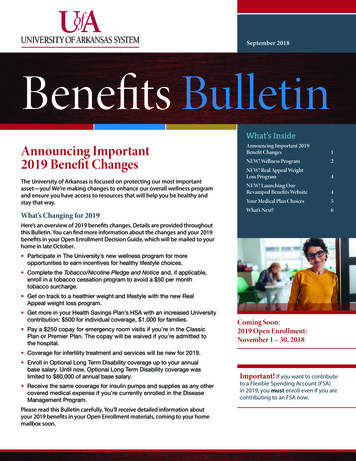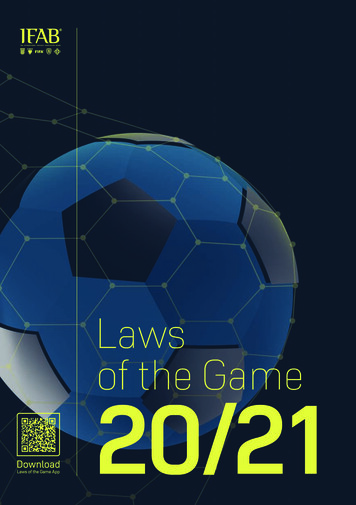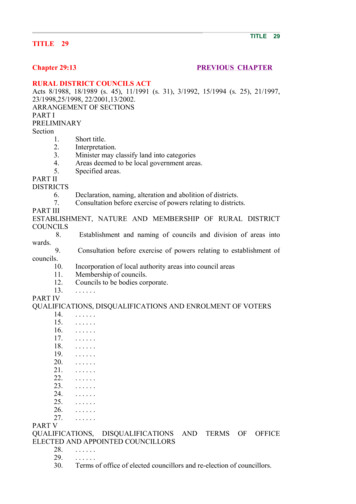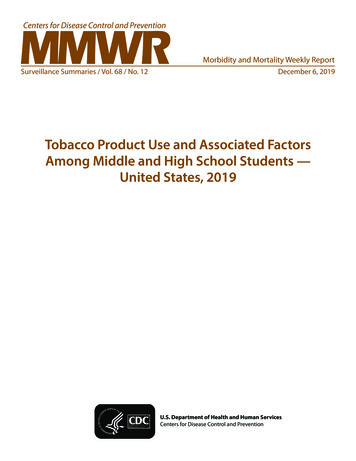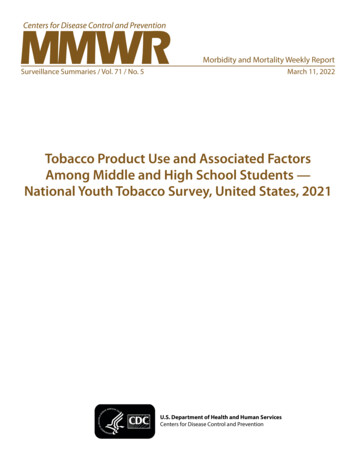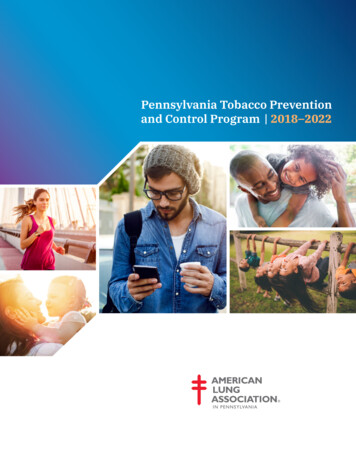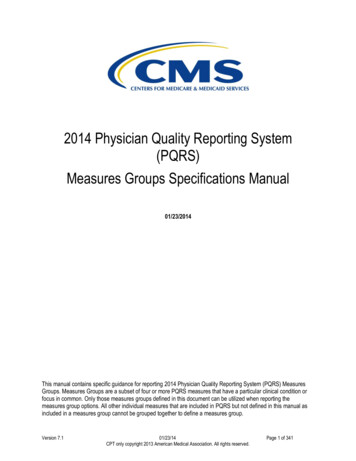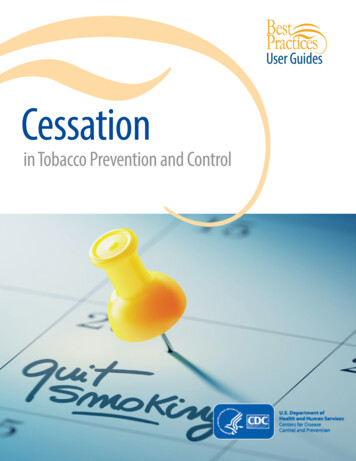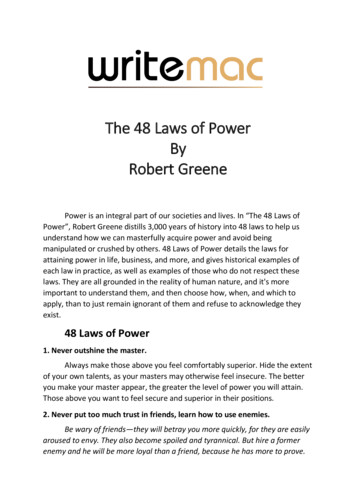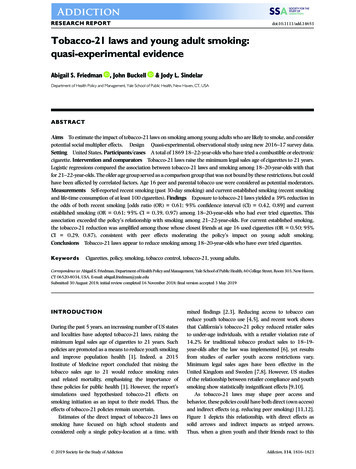
Transcription
RESEARCH REPORTdoi:10.1111/add.14653Tobacco-21 laws and young adult smoking:quasi-experimental evidenceAbigail S. Friedman, John Buckell& Jody L. SindelarDepartment of Health Policy and Management, Yale School of Public Health, New Haven, CT, USAABSTRACTAims To estimate the impact of tobacco-21 laws on smoking among young adults who are likely to smoke, and considerpotential social multiplier effects.DesignQuasi-experimental, observational study using new 2016–17 survey data.Setting United States. Participants/cases A total of 1869 18–22-year-olds who have tried a combustible or electroniccigarette. Intervention and comparators Tobacco-21 laws raise the minimum legal sales age of cigarettes to 21 years.Logistic regressions compared the association between tobacco-21 laws and smoking among 18–20-year-olds with thatfor 21–22-year-olds. The older age group served as a comparison group that was not bound by these restrictions, but couldhave been affected by correlated factors. Age 16 peer and parental tobacco use were considered as potential moderators.Measurements Self-reported recent smoking (past 30-day smoking) and current established smoking (recent smokingand life-time consumption of at least 100 cigarettes). Findings Exposure to tobacco-21 laws yielded a 39% reduction inthe odds of both recent smoking [odds ratio (OR) 0.61; 95% confidence interval (CI) 0.42, 0.89] and currentestablished smoking (OR 0.61; 95% CI 0.39, 0.97) among 18–20-year-olds who had ever tried cigarettes. Thisassociation exceeded the policy’s relationship with smoking among 21–22-year-olds. For current established smoking,the tobacco-21 reduction was amplified among those whose closest friends at age 16 used cigarettes (OR 0.50; 95%CI 0.29, 0.87), consistent with peer effects moderating the policy’s impact on young adult smoking.Conclusions Tobacco-21 laws appear to reduce smoking among 18–20-year-olds who have ever tried cigarettes.KeywordsCigarettes, policy, smoking, tobacco control, tobacco-21, young adults.Correspondence to: Abigail S. Friedman, Department of Health Policy and Management, Yale School of Public Health, 60 College Street, Room 303, New Haven,CT 06520-8034, USA. E-mail: abigail.friedman@yale.eduSubmitted 30 August 2018; initial review completed 16 November 2018; final version accepted 3 May 2019INTRODUCTIONDuring the past 5 years, an increasing number of US statesand localities have adopted tobacco-21 laws, raising theminimum legal sales age of cigarettes to 21 years. Suchpolicies are promoted as a means to reduce youth smokingand improve population health [1]. Indeed, a 2015Institute of Medicine report concluded that raising thetobacco sales age to 21 would reduce smoking ratesand related mortality, emphasizing the importance ofthese policies for public health [1]. However, the report’ssimulations used hypothesized tobacco-21 effects onsmoking initiation as an input to their model. Thus, theeffects of tobacco-21 policies remain uncertain.Estimates of the direct impact of tobacco-21 laws onsmoking have focused on high school students andconsidered only a single policy-location at a time, with 2019 Society for the Study of Addictionmixed findings [2,3]. Reducing access to tobacco canreduce youth tobacco use [4,5], and recent work showsthat California’s tobacco-21 policy reduced retailer salesto under-age individuals, with a retailer violation rate of14.2% for traditional tobacco product sales to 18–19year-olds after the law was implemented [6], yet resultsfrom studies of earlier youth access restrictions vary.Minimum legal sales ages have been effective in theUnited Kingdom and Sweden [7,8]. However, US studiesof the relationship between retailer compliance and youthsmoking show statistically insignificant effects [9,10].As tobacco-21 laws may shape peer access andbehavior, these policies could have both direct (own access)and indirect effects (e.g. reducing peer smoking) [11,12].Figure 1 depicts this relationship, with direct effects assolid arrows and indirect impacts as striped arrows.Thus, when a given youth and their friends react to thisAddiction, 114, 1816–1823
Tobacco-21 laws and young adult smokingFigure 1 Mechanism for tobacco-21 effect on young adult smoking.Solid arrows denote the policy’s direct effects on young adult behavior,while striped arrows denote indirect effects. If the individual and theirpeers respond to both the policy and each other’s behavior, these indirect effects will reinforce each other, such that the policy has an evengreater impact on own and peer smoking. We refer to this as a socialmultiplier effect. [Colour figure can be viewed at wileyonlinelibrary.com]policy in the same way, they may reinforce each other’sresponses, amplifying the policy’s impact (i.e. a ‘socialmultiplier effect’).To understand more clearly the relationship betweentobacco-21 laws and young adult smoking this studyconsiders two research questions, focusing on thosewho are likely to smoke: (1) how are tobacco-21 policiesrelated to smoking; and (2) is this relationship moderatedby peer-smoking?. ‘Likely to smoke’ is operationalized byselecting on those who have ever tried a combustible orelectronic cigarette, as 87% of US smokers first triedcigarettes by age 18, and there is some concern thatearly e-cigarette users may be more likely to take upsmoking later [13]. Specifically, newly collected survey datacover self-reported smoking behavior and demographicsamong 18–22-year-old ‘ever-triers’.To examine the relationship between tobacco-21policies and smoking among young adult ever-triers,analyses compare current smoking between those residingin areas with versus without a tobacco-21 law atinterview, among age groups that would, versus wouldnot, have been bound by these policies (18–20 versus21–22). Both unadjusted means and regressions adjustingfor demographic differences are presented. A negativerelationship between tobacco-21 exposure and currentsmoking is hypothesized.Next, analyses consider whether peer effects amplifythe tobacco-21 to smoking relationship. A vast literatureprovides theoretical and empirical support for thepresence of peer effects in adolescent smoking [14–18].This includes evidence for social multiplier effects,whereby peer responses to a policy reinforce the individual’s response and vice-versa [18]. In the context of atobacco-21 policy, a social multiplier would suggest that 2019 Society for the Study of Addiction1817the law’s impact on smoking should be strongest amongthose whose friends were likely to smoke absent atobacco-21 restriction; i.e. where a tobacco-21 restrictioncould reduce smoking among one’s friends. Thishypothesized effect goes in the opposite direction of theexpected impact from friend-selection. That is, if youthswith the highest demand for cigarettes choose friendswho are likely to smoke, friend-selection alone predictsless of a tobacco-21 response in this group thanamong those with non-smoking friends. To examine this,regressions use smoking among one’s closest friends atage 16 as a proxy for friends’ susceptibility to smokingin the absence of tobacco-21 policies (as few, if any,respondents were exposed to these policies at age 16).Project aimsUsing survey data on 18–22-year-olds who have tried combustible and/or electronic cigarettes, this analysis aims to:1 Estimate how tobacco-21 laws relate to currentsmoking among 18–20-year-olds who are otherwiselikely to smoke; and2 Test for evidence of a social multiplier effect in theserelationships.We expect (1) a differential reduction in smoking among18–20-year-olds who are subject to tobacco-21 laws,relative to the trends among 21–22-year-olds in areas withthe same policies; and (2) that this relationship will bestrongest for those whose close friends at age 16 vaped orsmoked, consistent with a social multiplier effect.METHODSDesignQuasi-experimental analyses use new, cross-sectionalsurvey data to compare current smoking among 18–20year-olds versus 21–22-year-olds, in areas that did, versusdid not, have tobacco-21 laws at interview. To focus onthose who were otherwise likely to smoke, the survey’ssample is restricted to individuals who have ever tried acombustible or electronic cigarette.ParticipantsThe authors commissioned an online survey of 200318–22-year-old US residents who had ever tried either anelectronic or combustible cigarette (‘ever-triers’), withquestions focused on respondents’ cigarette use anddemographics. Qualtrics administered the survey fromNovember 2016 to May 2017, with respondents recruitedfrom standing panels used for academic and market research (see Supporting information, Appendix, for furtherdetails). To increase generalizability, sampling quotas weredefined to match the 2015 National Health InterviewAddiction, 114, 1816–1823
1818Abigail S. Friedman et al.Survey’s weighted distribution of respondents who reported ever-use of either combustible or electronic cigarettes, by year-of-age, sex, education and census region.Qualtrics provided full data on 2710 US residents aged18–22. The 707-person oversample was used to fill in sampling quotas in case of data quality issues. Specifically, 52 ofthe 2710 respondents were excluded based on the following quality checks: four for straight-lining (clicking thesame response for a series of questions on a Likert scale),one for failing a minimum time threshold (i.e. speedingthrough the survey); and 47 for mutually exclusive ageresponses (e.g. reported age at first cigarette use exceedsage-at-interview; reported age and year of birth conflict).Twenty-seven additional observations were dropped dueto probable duplicate responses (where two interviewshad the same IP address, sex, birth month and birth year).Using the 2631 remaining observations, the contractedsample of n 2003 was populated with the latest surveydate responses until each quota was filled.While the data cover all 50 states and the District ofColumbia, analyses omit respondents from Massachusettsand New York. These states had the earliest tobacco-21adopting localities, such that some 21–22-year-oldstherein may have been bound by tobacco-21 restrictionssince age 18. As prior policy-exposure could impactcurrent smoking, including these respondents might biasthe between-age-group comparisons towards a nullresult. Omitting them also ensures that findings are notdriven by early-adopting regions, which may differ fromlater-adopters.The resulting analytical sample contained 1869respondents.MeasuresDependent variablesAnalyses focus on two binary, dependent variables: recentsmoking (in the past 30 days) and current establishedsmoking (recent smoking among those whose life-timesmoking exceeds 100 combustible cigarettes). While recentsmoking may include new experimenters, currentestablished smoking (‘established-smoking’ for brevity)provides a clearer signal of regular use. [19]ExposureThe exposure of interest is a binary indicator for whetherthe respondent resided in a location with a tobacco-21law in effect at interview. Specifically, the exposure variableequals 1 if (1) a respondent’s state implemented a tobacco21 law by their interview date or (2) they lived in the largest city in their state and that city was covered by atobacco-21 policy at interview. Exposed respondents livedin Hawaii (n 3), California (n 223), New Jersey 2019 Society for the Study of Addiction(n 46), Chicago, IL (n 21), Columbus, OH (n 8) andKansas City, MO (n 6), with 16.4% of the sample exposed(n 307) [20]. Most unexposed respondents faced tobaccominimum legal sales ages of 18, with the exception beingthose in Alaska, Alabama and Utah, where the minimumage was 19.Substate locations are unavailable for individuals livingoutside their state’s largest city. Thus, some respondentsmay be misclassified as unexposed to tobacco-21 laws iftheir town had a policy but their state did not. Suchmisclassification could bias estimates towards the null.However, this is not a problem for state-level laws, andtwo-thirds of substate tobacco-21 policies were inMassachusetts or New York and thus are not in the analytical sample [21]. This reduces the potential extent ofexposure misclassification.Control variablesBinary indicators adjust for differential smoking by respondent demographics: sex, a binary ‘under-age-21’ indicator,race (black, other and multiple race; ‘white race only’ asthe reference group), Hispanic ethnicity, current studentstatus (‘current student’ and ‘not currently a student butplans to enroll within next year’; non-student as thereference group), whether any parent attended college,and urbanicity (urban and suburban; rural as the reference group).As peer and parental tobacco use affect adolescentsmoking [11,12], two additional controls adjust forwhether (a) any of the respondent’s three closest friendsat age 16 used combustible or electronic cigarettes at thattime, and (b) a parent used combustible or electronic cigarettes when the respondent was age 16. As tobacco-21laws were implemented after the analytical sample’srespondents turned 16, these controls capture the relationship of peer and parental use to respondent smoking,separate from any influence of tobacco-21 laws on peerand parental behavior.Tobacco-21 policies may be correlated with other tobacco policies. To address potential confounding, controlsare included for state plus local combustible cigarette taxesand comprehensive smoke-free indoor air laws (i.e. covering restaurants, bars and private work-sites). As with thetobacco-21 variable, these controls are coded based onthe respondent’s state and residence in its largest city.Survey question wording is given in the Supportinginformation Appendix.AnalysesTable 1 presents means for variables used in the analyses.Table 2 displays descriptive statistics of both recent andcurrent established smoking rates by tobacco-21 exposure,stratified by age-group (panel A) and, for 18–20-year-olds,Addiction, 114, 1816–1823
Tobacco-21 laws and young adult smokingTable 1 Summary statistics.Full samplePercentage (n)Tobacco useRecent (past 30-day) smokingCurrent established smokingAny parent smoked or vaped whenrespondent was aged 16 yearsClose friend smoked or vaped whenrespondent was aged 16 yearsTobacco policy exposureTobacco-21 lawsComprehensive smoke-free indoor airrestrictionsCombustible cigarette tax (state local)DemographicsAge 21 yearsMaleAt least one parent attended collegeHispanicRaceWhite onlyBlackOtherMultipleCurrent student statusCurrent studentNot current student, plans to enrollwithin the next yearNot a studentUrbanicityRuralSuburbanUrbanTotal number of observations65.1% (n 1216)54.7% (n 1022)54.0% (n 1009)67.1% (n 1254)16.4% (n 307)54.9% (n 1026) 1.56 (n 1869)48.7% (n 911)58.6% (n 1095)59.2% (n 1106)15.9% (n 298)77.5% (n 1449)11.7% (n 219)11.5% (n 215)3.9% (n 72)48.3% (n 902)24.5% (n 458)27.2% (n 509)25.5% (n 477)42.5% (n 794)32.0% (n 598)1869Means for demographic, tobacco use and policy exposure variables are basedon newly collected survey data on 18–22-year-old ‘ever-triers’ of combustible and/or electronic cigarettes; ns give the number of non-zero observationsfor each variable in parentheses. Respondents from New York and Massachusetts are omitted.by whether a close friend at age 16 smoked or vaped(panel B). Table 3 presents logistic regressions comparingsmoking among 18–20- and 21–22-year-olds based onexposure to tobacco-21 laws at interview.Specifically, binary indicators for recent smoking(models 1–3) and established-smoking (models 4–6) areregressed on demographic and policy controls, plus twoexposure variables: the presence of tobacco-21 laws andan interaction between this variable and an under age21 indicator. The uninteracted tobacco-21 coefficientcaptures the correlation between tobacco-21 laws andsmoking in the general young adult population. The interaction term reflects any additional policy impacts specific tounder 21-year-olds, beyond the general relationship.Analyses are run with and without state fixed-effects sothat results can be compared across these specifications 2019 Society for the Study of Addiction1819to verify that state-specific factors do not drive the coefficient estimates. In all cases, robust standard errors areclustered at the state level.To consider whether peer effects shape the relationshipbetween tobacco-21 laws and smoking, a third specification is assessed (columns 3 and 6). These regressions addtwo terms to the state fixed-effects analyses: interactionsbetween the under 21-by-tobacco-21 term and binary indicators for (1) having close friends who smoked or vapedwhen the respondent was 16, and (2) having a parentwho smoked or vaped when the respondent was 16. Alow covariance (0.13) between the friend- and parentaluse indicators allows assessment of their distinct relationships with current smoking. The friends’ use interactionaddresses whether the policy’s impact is stronger amongthose whose close friends smoked or vaped as youths. Theparental use interaction allows for the possibility ofdifferential policy effects among those who grew up witheasier access to or less stringent attitudes towards tobaccoproducts in their household. If peer effects moderatetobacco-21’s impacts, then the policy’s association withsmoking would be strongest among those whose friendsmight also have responded by reducing their smoking,holding parental behavior constant. Thus, a statisticallysignificant peer use interaction term would support thehypothesis that tobacco-21 laws have indirect effects viapeer effects.Specification checks repeat each regression using linearprobability models instead of logistic regressions, as thelatter may yield biased parameter estimates whenheteroskedasticity is present. Analyses use Stata 14 statistical software. Yale University’s Institutional Review Boardapproved this study (HIC Protocol no. 1307012384).RESULTSTable 1 presents sample summary statistics. As the dataare limited to electronic and combustible cigarette evertriers, respondent smoking rates are high, at 65% for recent use (n 1216) and 55% for established-smoking(n 1022). Similarly, 54% report at least one parenthaving smoked or vaped when they were 16 (n 1009)and 67% report having a close friend who did so at thatage (n 1254).Table 2’s cross-tabulations suggest potential impactsfrom tobacco-21 policies. Specifically, panel A shows that18–20-year-olds who are not exposed to tobacco-21 lawshave a recent smoking rate of 64%, compared to 46% forthose who are exposed: an 18 percentage-point difference.Established smoking shows a similar gap, with rates of 50versus 28%, respectively. However, these differences maynot be fully attributable to the tobacco-21 laws. Indeed,21–22-year-olds also exhibit differential smoking rates bytobacco-21 exposure, although they were not bound byAddiction, 114, 1816–1823
1820Abigail S. Friedman et al.Table 2 Smoking rates stratified by tobacco-21 exposure(A) By age groupRecent SmokingCurrent established smokingAges (years)No Tobacco-21Tobacco-21Smoking gapNo tobacco-21Tobacco-21Smoking gap18–2063.7% (n 763)45.9% (n 148)50.3% (n 763)28.4% (n 148)21–2269.5% (n 799)67.3% (n 159)17.8 percentagepoints2.2 percentagepoints63.5 (n 799)56.0% (n 159)21.9 percentagepoints7.5 percentagepoints(B) By whether closest friends at age 16 smoked or vaped, 18–20-year-olds onlyRecent smokingCurrent established smokingFriends’ UseNo Tobacco-21Tobacco-21Smoking gapNo Tobacco-21Tobacco-21Smoking GapYes67.9% (n 570)47.0 (n 117)57.4 (n 570)30.8% (n 117)No51.0% (n 243)51.7% (n 60)20.9 percentagepoints0.7 percentagepoints31.3% (n 243)31.7% (n 60)26.6 percentagepoints0.4 percentagepointsThis table presents average smoking rates by tobacco-21 exposure stratified by age-group (A) and, for 18–20-year-olds only, by whether any ofthe respondent’s three closest friends at age 16 smoked or vaped. Respondents from New York and Massachusetts are omitted. ‘Smoking gap’ is thedifference between the smoking rate among those with versus with tobacco-21 exposure, within a given stratum (i.e. row); that is, smoking gap smoking rate no tobacco-21 exposure, row X – smoking rate tobacco-21 exposure, row X.these policies. This group’s gaps—2 percentage points forrecent smoking and 7 percentage points for establishedsmoking—may reflect variations in other factors correlated with both young adult smoking and tobacco-21 laws(e.g. cigarette tax rates).Subtracting the differential smoking rate observedamong the older age group from that for the youngergroup excises differences in smoking rates that are notdirectly due to the age-21 restriction. Thus, the rawstatistics suggest that tobacco-21 exposure may contributeto the 16 percentage-point difference in the recentsmoking gap (18 minus 2%) and 15 percentage-point difference in the established smoking gap (22 minus 7%) between the 18–20- and 21–22-year-old age groups.Panel B is similarly suggestive regarding a social multiplier effect. Among 18–20-year-olds whose closest friendsat age 16 smoked or vaped, those exposed to tobacco-21laws are more than 20 percentage points less likely to berecent and established smokers than those not exposed.Among those whose closest friends at age 16 did not smokeor vape, the corresponding smoking gaps are 0.7and 0.4, respectively. Thus, tobacco-21 exposure is associated with greater reductions in smoking among thosemost susceptible to a social multiplier effect.Logistic regressions test these relationships more formally, controlling for individual demographics, tobaccopolicies and state fixed-effects. Comparing the main specification without and with state fixed-effects (Table 3,columns 1 and 4 versus 2 and 5) shows that including 2019 Society for the Study of Addictionstate fixed effects inflates the tobacco-21 odds ratios(ORs). Collinearity between the fixed-effects and state-leveltobacco-21 laws explains this shift. Thus, while the noninteracted tobacco-21 indicator controls for the associationbetween tobacco-21 exposure and smoking among18–22-year-olds, its coefficient should not be interpretedas an estimate of the policy’s across-age-group effect [22].This collinearity does not compromise the tobacco-21interaction variables. Specifically, the interaction terms’coefficients are identified by comparing policy responses between age groups within a state, and thus are not collinearwith state fixed-effects. Indeed, the ORs on these terms aresimilar whether or not state fixed-effects are included:statistically significant at 0.61 in all baseline regressionspecifications, for recent and also established-smoking(Table 3, columns 1, 2, 4 and 5). Thus, exposure to atobacco-21 law is associated with a 39% drop in theodds that an 18–20-year-old ever-trier will be a recentsmoker [OR 0.61, confidence interval (CI) 0.42,0.89; P-value 0.01] or a current smoker [OR 0.61;CI 0.39, 0.97; P-value 0.04] at interview, comparedto 21–22-year-old ever-triers living in the same state.Specifications 3 and 6 consider the mechanism behindthis association, adding interaction terms for the under-21by tobacco-21 indicator by (a) parental and (b) closefriends’ use of combustible or electronic cigarettes whenthe respondent was 16. Adding these controls yields a statistically insignificant odds ratio on the under-21 bytobacco-21 indicator for both recent smoking [OR 1.07,Addiction, 114, 1816–1823
Tobacco-21 laws and young adult smoking1821Table 3 Logistic regression analysis of tobacco-21 laws and smoking, odds ratio/(t-statistic)/P-valueRecent smokingTobacco-21 lawAge 21 yearsTobacco-21 law* Age 21 yearsCurrent established smoking(1)(2)(3)(4)(5)(6)1.0551(0.353)P 0.720.8470( 1.498)P 0.130.5931**( 2.770)P 0.011.7146(1.148)P 0.250.8413( 1.459)P 0.140.6125*( 2.566)P 0.010.8517( 1.031)P 0.300.6459**( 4.542)P 0.000.6015*( 2.279)P 0.021.4094(0.884)P 0.380.6280**( 4.443)P 0.000.6116*( 2.103)P 0.041.4231**(2.822)P 0.001.5683**(3.610)P 0.002.5893**(3.674)P 0.00No18690.0590.6511.4262**(2.722)P 0.011.5755**(3.452)P 0.003.1304**(4.376)P 0.00Yes18570.0830.6481.7475(1.127)P 0.260.8366( 1.501)P 0.131.0698(0.235)P 0.810.5039( 1.669)P 0.100.8294( 1.039)P 0.301.4491**(2.579)P 0.011.6744**(4.234)P 0.002.9618**(3.881)P 0.00Yes18570.0840.6481.6612**(5.026)P 0.001.7157**(3.892)P 0.002.1179**(3.214)P 0.00No18690.1090.5471.6885**(4.957)P 0.001.6789**(3.677)P 0.002.6513**(4.081)P 0.00Yes18570.1290.5441.4359(0.876)P 0.380.6251**( 4.483)P 0.000.9360( 0.217)P 0.830.5364**( 3.467)P 0.001.0253(0.134)P 0.891.6847**(4.601)P 0.001.7526**(4.229)P 0.002.5756**(3.849)P 0.00Yes18570.1290.544Tobacco-21 law *Age 21* Close friendsmoked or vaped when R was 16Tobacco-21 law *Age 21* Parentsmokedor vaped when R was 16Any parent smoke or vape whenR was 16Any close friend smoke or vape whenR was 16ConstantState fixed-effectsn2Adjusted RDependent variable meanLogistic regression models consider how age 21 tobacco sales restrictions impact smoking at interview. Models compare 18–20-year-olds with 21–22-yearolds, and omit respondents (R) from New York and Massachusetts, as local restrictions in those states’ restrictions are old enough that some 21- and 22-yearold respondents therein could have been bound by the restrictions when they were age 18. Controls not indicated in the table are the (state local) combustiblecigarette tax and fixed-effects for the presence of comprehensive smoke-free indoor air laws, male sex, race (black, multiple, other, with white as the referencegroup), Hispanic ethnicity, urbanicity (suburban, urban, with rural as the reference group), whether any parent attended college and student status (currentstudent, planning to enroll in the coming year, with non-student as the reference group). Columns 1 and 4 give main specification results; 2 and 5 add controlsfor state fixed-effects; 3 and 6 add additional interaction terms listed in the table. Standard errors are clustered by state. *(**) denote statistical significance atthe 0.05 (0.01) level.confidence interval (CI) 0.610, 1.877; P-value 0.814]and established smoking (OR 0.94, CI 0.515, 1.701;P-value 0.828). The parental use interaction is statistically insignificant and close to 1 in all cases. However,the friends’ use interaction term is statistically significantin the established-smoker regression (OR 0.54,CI 0.377, 0.763; P-value 0.001). Thus, tobacco-21policies are associated with a 50% drop in the odds ofestablished smoking among 18–20-year-old ever-trierswhose friends smoked or vaped at age 16: OR exp[ln(0.54) ln(0.94)] 0.5020, CI 0.289, 0.871;P-value 0.014). The elevated tobacco-21 effect in thissubgroup is consistent with a social multiplier effect inyoung adults’ responses to tobacco-21 policies.Evaluating these specifications with linear probabilitymodels yields similar findings (see Supporting informationAppendix, Table S1). These analyses are repeated with 2019 Society for the Study of Addictionrecent and established vaping as the dependent variables,yielding statistically insignificant results across the board(see Supporting information, Appendix Table S2). Vapingregression results are not presented here due to concernsabout statistical power given lower vaping rates and relatively high standard errors.DISCUSSIONThis study finds that tobacco-21 policies are associatedwith a 39% reduction in the odds of recent and establishedsmoking among 18–20-year-olds who have ever tried acombustible or electronic cigarette, compared to similar21–22-year-olds. Sensitivity checks indicate that, forestablished smoking, this association is differentially stronger among 18–20-year-olds whose close friends vaped orsmoked at age 16. Specifically, such youths exhibit a 46%Addiction, 114, 1816–1823
1822Abigail S. Friedman et al.reduction in their odds of established smoking in responseto tobacco-21 exposure, above and beyond the full agegroup’s policy-response. These findings are consistent witha social multiplier effect.This research adds to the literature in several ways: itconstitutes one of the first studies to estimate the relationship between tobacco-21 policies and smoking among18–20-year-olds; uses a quasi-experimental analysis toexamine new survey data; and provides both simplecomparative statistics and controlled regression analysesto consider smoking among ever-triers of combustibleand/or electronic cigarettes. The findings provide criticalempirical support for tobacco-21 policies, as well asevidence for a social multiplier effect.LimitationsLimitations stem primarily from the data. First, thesample’s restriction to ever-triers means that analyses donot reflect the full population’s policy responses. Resultsshould be interpreted as applying to those who are particularly susceptible to tobacco use: a critical group.Similarly, as Qualtrics recruited respondents from a standing panel, the analysis is not a probability sample andmay under-represent some populations. While samplingquotas increase the sample’s representativeness of thegeneral population in terms of age, sex, education andcensus region, they do not ensure representativeness forspecific states with versus without tobacco-21 laws, oraddress race or income differences between these areas.This may affect the results’ generalizability, particularlyto under-represented groups. Generalizability may alsobe constrained by the exclusion of Massachusetts andNew York residents, and coverage of only six tobacco-21policies (three state-level, three local). Critically, selfreported smoking data may underestimate true smokingrates [23]. However, given that respondents are selfadmitted ever-triers, they may be less inclined to misrepresent their current smoking status. Because tobacco-21laws have been in place for relatively few years, wecannot estimate the impact of exposure throughoutadolescence.Due to potential misclassification of
Abigail S. Friedman ,JohnBuckell&JodyL.Sindelar Department of Health Policy and Management, Yale School of Public Health, New Haven, CT, USA . tobacco-21 laws and young adult smoking this study considers two research questions, focusing on those who are likely to smoke: (1) how are tobacco-21 policies .

